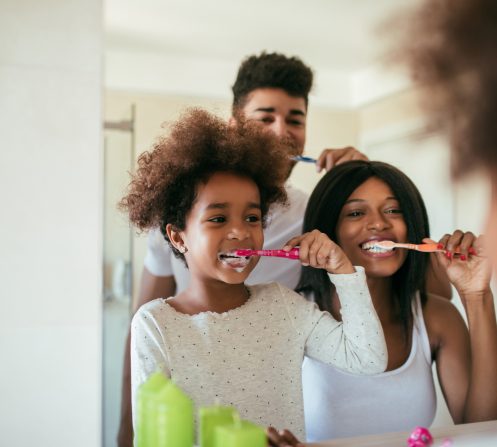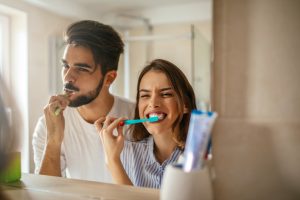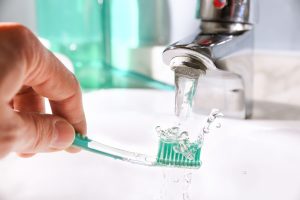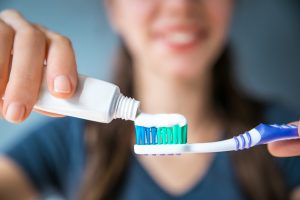
With the countless amounts of toothbrushes on store shelves, how do you know which is the best fit for you? What material should your toothbrush be and how often should you be replacing them? Below you’ll find answers to many of these questions to help you better understand the most effective way to brush your teeth!
It is recommended that you use a soft or ultra-soft bristled toothbrush. Softer bristles are more effective at cleaning gum lines and are more gently on the gum tissues at the same time. If you use harder bristles, over time they can cause important tooth enamel and dentin to wear away, essentially weakening the crown of the tooth over time.
At minimum, you should replace your toothbrush every 3 months. However, if you have recently suffered from a cold or flu, you should be sure to replace your toothbrush right away, as continuing to us it could re-expose you to bacteria. Do not let your toothbrush get so worn in or frayed, be sure to replace your toothbrush (manual & electric) for optimal cleanliness!

Dental hygiene depends on effective daily habits, but in addition to choosing toothpaste that’s formulated for your teeth, picking out the perfect brush, and flossing each day, you also need to think about how long you brush. There’s a sweet spot, but it comes as no surprise that most people don’t brush their teeth for nearly long enough—ideally, everyone should brush their teeth for two to three minutes, but most of us only do it for 30 seconds. Ask yourself the following questions to determine if you’re brushing long enough.
If the answer is no, then you’re not brushing your teeth long enough. It’s essential to brush every tooth in your head from front to back and top to bottom. Keep in mind that you can’t do that if your brushing style involves randomly scrubbing your teeth. Brush your chompers thoughtfully, moving the bristles of your toothbrush in circles over your teeth.
Take a look at your toothbrush. How are the bristles looking these days? If they’re all spread out and squashed, then you have an aggressive brush stroke, which suggests you don’t spend enough time brushing your teeth. How could you? Your teeth probably ache after half a minute. Harsh brushing is often the reason behind bleeding gums, too.
Just a few decades ago, dentists hammered home the importance of brushing three times a day, but that feat proved impossible for any member of the population attending work or school. Today, the recommended daily minimum is twice a day. Needless to say, brushing your teeth less than that means you definitely aren’t brushing them long enough — or often enough. Don’t forget that in addition to brushing regularly, you should floss once a day.
If your smile isn’t quite what you’d like it to be, make an appointment with cosmetic dentist, Dr. Braverman at New York City Cosmetic Dentistry Center. He can make your smile just perfect.
It may seem contrary to everything you’ve ever heard about dental hygiene, but brushing your teeth right after every meal isn’t always a good idea. If you’ve made a habit of brushing after every meal to clean out stray food particles and freshen breath, read on to find out why you might want to alter your routine slightly.
Your teeth become most vulnerable to damage directly after eating and drinking. Acid in the food and drinks you consume softens the coating of enamel on the outside of your teeth. When you brush too soon after eating or drinking your brushing can wear down and harm this enamel. Brushing 2-3 times a day is still an important action, but doing so directly after meals may not be the best option. Instead, wait at least an hour after eating and then take the time to brush and floss.
Brushing at night is the most important. When your mouth dries out at night, your teeth become most susceptible to bacterial damage, which can harm even the most beautiful smile. Then, upon waking up it is important to brush away any plaque that may have collected overnight. With these two brushing cycles being high up in importance, brushing again an hour or so after lunch is the only necessary additional cleaning, as brushing more than 3 times a day can damage gums.

It’s one of those things we do so often, we rarely think about it anymore. Even so, most of us are doing it wrong. According to the American Dental Association (ADA), subpar tooth brushing technique is partly to blame for the nation’s poor oral health. What the problem? Here’s a brief list from dental professionals.
In addition to eliminating odors, brushing helps remove dental plaque, which is the primary cause of tooth decay and gum disease. This plaque accumulates along the gumline and can be safely removed with a few seconds of vigorous brush. But if you use the wrong toothbrush, particularly one that is too big, you will not be able to clean those hard-to-reach places.
Some toothbrushes have straight bristles and others have angled ones. Experts recommend trying both types out to see which works best with your brushing technique. It is also important to note that bristles should be stiff enough to remove dental plaque, but not so still stiff that they irritate the gums.
When it comes to cleaning the teeth, nothing can compare with brushing; not flossing or gargling (mouthwash). The only problem is most of us don’t brush long enough. According to the ADA, all adults should brush for at least two minutes each session, which for times more than the 30 seconds the average adult devotes to the task.
Some people buy the most expensive toothbrush on the market while others don’t put any thought into their toothbrush at all. Although there isn’t one right toothbrush for everyone, it’s important to find the right toothbrush for you.
Although the brand name doesn’t necessarily matter, you do want to make sure your toothbrush comes from a reputable manufacturer and not from the dollar bin. Your toothbrush is going into your mouth at least twice a day, and you want to make sure the materials are safe. When you spend extra money on your toothbrush, you also get other benefits like a brush that is designed to clean every crevice and take care of your gums. Cheap toothbrushes just aren’t capable of cleaning your mouth well and improving your oral hygiene.
If you use a traditional toothbrush, you may want to consider upgrading to an electric toothbrush. It’s completely possible to keep your mouth healthy with a manual toothbrush if you consistently brush long enough. However, if you have wrist issues, like carpal tunnel or tendonitis, it might be easier to use an electric toothbrush and let it do the work. If you don’t think you brush as long as you should, an electric toothbrush can take out the guessing game for you.
Make sure your toothbrush is comfortable in your hand and your mouth. Different shaped toothbrushes are better suited for different mouths so if something feels off, keep shopping. Furthermore, if it hurts to brush, you aren’t doing it right. Even though you might be tempted to use hard bristles to really scrub, it can be damaging to your teeth and your gums.

The sheer number of brands of toothpaste on the oral hygiene aisle is enough to feel overwhelming. When you consider the different flavors, specialties and your specific needs, it is enough to make you pick up the cheapest tube and walk away. Keep these suggestions in mind the next time you’re perusing toothpastes to help you choose a toothpaste that you feel comfortable using twice a day, everyday.
When choosing a toothpaste that will benefit your teeth the most, make sure that you choose a brand that has been approved by the American Dental Association.
If your teeth are prone to stubborn tartar, consider using a tartar control specific paste. Tartar-control toothpaste contain sodium pyrophosphate and hexametaphosphate, which help prevent tartar and stains from forming on teeth and around the gums.
Most antimicrobial toothpaste contains fluoride, which is great for keeping teeth strong and protecting against cavities, as well as sensitivity.
If you are interested in whitening your teeth, regularly using whitening toothpaste can reduce stains and make teeth appear whiter. If you have sensitive teeth however, it may be best to choose a sensitivity-specific toothpaste for daily use as whitening toothpaste to contain chemicals and abrasive ingredients that can aggravate sensitive areas.
In order to keep your teeth healthy for many years to come, not only is brushing a vital part to keep up with, but visiting your dentist for regular exams is vital as well! Contact us today to schedule your appointment!